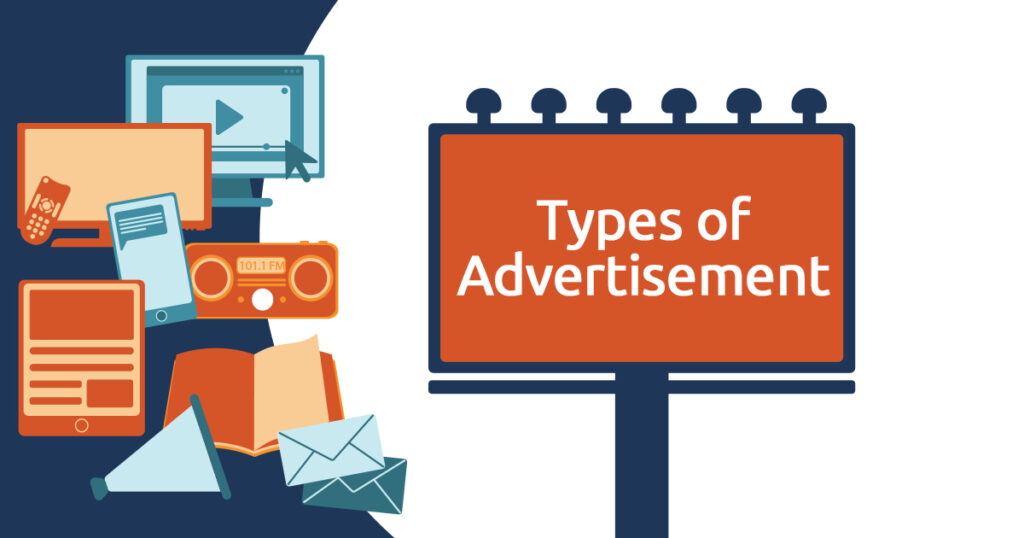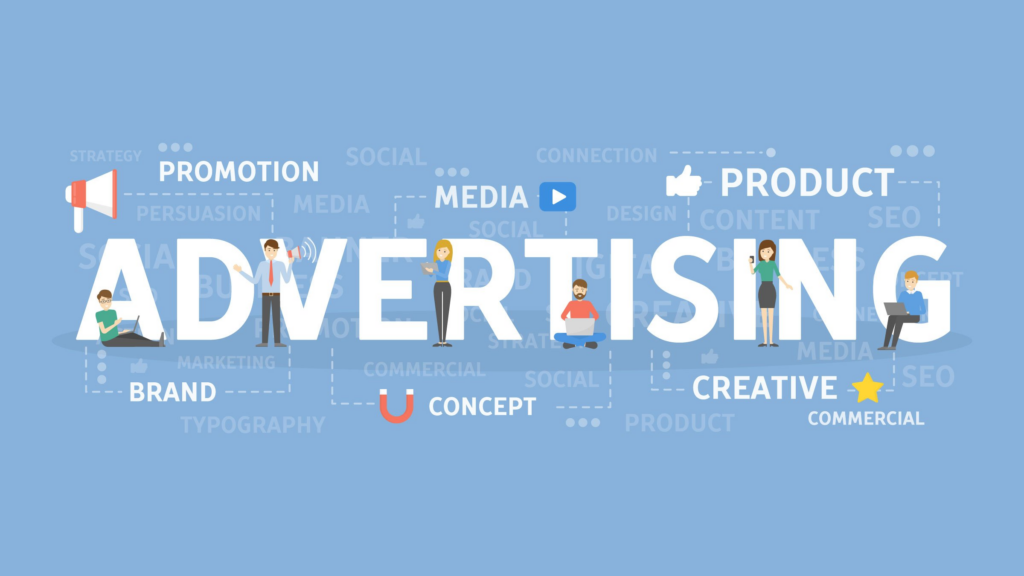
Advertising is the process by which a business or organization uses planned and strategic promotional activities to convey information to a target audience through various media, to achieve specific marketing goals. So, what are the different types of advertising? How should we choose the right one?
What is Advertising?
In detail, advertising is a commercial activity that disseminates information through various media (such as television, newspapers, the internet, outdoor billboards, etc.) with the main goal of promoting products, services, or brands to attract potential consumers' attention, boost sales, or enhance brand image.
The definition of advertising typically includes the following elements:
- Target Audience: Advertising needs to be directed at a specific target audience, which comprises potential consumers or groups interested in the content of the advertisement.
- Information Transmission: Advertising needs to convey clear information, whether it is about the characteristics, or benefits of a product or the provision of a service.
- Media Channels: The channels through which advertising information is delivered, such as television, radio, the internet, social media, newspapers, magazines, outdoor advertising, etc.
- Objectives: The specific goals that advertising aims to achieve, such as enhancing brand awareness, driving sales, changing consumer perceptions, etc.
- Content Creativity: The textual, visual, video, and audio content that an advertisement includes, as well as the creativity and mode of expression.
Functions of Advertising

Information Dissemination
Advertising conveys information about products, services, or brands to the target audience through images, text, sound, and video. This information may include product features, prices, usage methods, promotional activities, etc.
Persuasion and Influence
The purpose of advertising is to persuade potential consumers to choose a particular product or service. It attempts to influence consumers' attitudes and purchasing behavior through creative expression, psychological cues, and emotional resonance.
Brand Building
Advertising helps to establish and reinforce brand image, making consumers recognize and favor the brand, thus standing out in the competition.
Market Promotion
Advertising is an important part of marketing, helping businesses expand market share, and increase the visibility and sales of products or services through planned promotional activities.
What is the Purpose of Advertising?
The purpose of advertising is to influence consumer purchasing decisions by shaping brand image, providing product information, and stimulating purchase desire, thereby encouraging consumers to take action. Advertising can also serve non-commercial purposes, such as public service announcements, which aim to raise awareness about social issues or change public behavior.
What Makes a Good Advertisement?
A good advertisement can attract the target audience, convey a clear message, establish an emotional connection, and ultimately prompt consumers to take action. Additionally, it should comply with laws and regulations, uphold social responsibility, and be cost-effective.
Good advertisements typically have the following characteristics:
- Clear Objectives: A good advertisement has clear objectives and a well-defined target audience, clearly conveying the value of the product or service to consumers.
- Innovation and Creativity: The creativity and presentation of the ad should be novel, providing a surprise or a deep impression to the audience. Innovative ads are more likely to be remembered and shared by the audience.
- Clarity of Information: The ad's information should be concise and easy to understand. The audience should be able to grasp the core message of the ad in a short time and understand the features and benefits of the product or service.
- Emotional Connection: A good advertisement can evoke emotional resonance in the audience, triggering emotional responses such as joy, inspiration, excitement, or identification. This emotional connection helps build brand loyalty.
- Attention-grabbing: A good ad can stand out among a multitude of information and quickly capture the target audience's attention. This often requires unique creativity, novel presentation, and visual impact.
- Relevance: The ad should be relevant to the specific target audience, with content that aligns with their needs and interests. Precise targeting can enhance the ad's effectiveness and conversion rate.
- Call to Action (CTA): A good advertisement usually includes a clear call to action, guiding the audience to take specific actions, such as purchasing, registering, or clicking a link.
- Brand Consistency: The style, tone, and content of the ad should be consistent with the brand image and values, enhancing brand recognition and loyalty.
- Adaptability: A good ad can adapt to different media and platforms, as well as various cultural and social contexts.
- Measurable Effectiveness: Advertising campaigns should have clear goals and be evaluated through relevant metrics, such as click-through rates, conversion rates, and sales growth. Measurable effectiveness helps optimize advertising strategies.
- Authenticity and Credibility: The content of the ad should be truthful and reliable, avoiding exaggeration and false claims. Integrity is the foundation of building brand trust and long-term relationships.
- Legal and Ethical Compliance: The ad should comply with relevant laws, regulations, and ethical standards, avoiding misleading or false advertising.
- Social Responsibility: Good advertisements not only focus on commercial interests but also bear social responsibility, conveying positive social messages.
For example, Nike's "Just Do It" ad campaign, with its powerful slogan, inspiring stories, and celebrity endorsements, has successfully captured the attention and resonance of global consumers, significantly enhancing brand image and sales. These ads not only highlight the product's advantages but also convey the brand's core values, making them classic examples of effective advertising.
Types of Advertising
There are various types of advertising, which can be classified based on different criteria as follows:
Classified by Media Type

1. Television Advertising: Advertisements aired during television programs or channels. Combining visual and auditory elements, they convey rich information.
2. Radio Advertising: Advertisements broadcasted through radio stations, presented in audio format, suitable for delivering concise information.
3. Newspaper Advertising: Advertisements published in newspapers, typically including classified ads, full-page ads, half-page ads, etc.
4. Magazine Advertising: Advertisements published in magazines, commonly found in fashion, lifestyle, and business magazines, featuring vivid imagery with excellent visual effects.
5. Internet Advertising:
- Display Advertising: Image or animation ads on web pages.
- Video Advertising: Ads embedded within video content, such as YouTube ads.
- Search Engine Advertising: Keyword ads displayed through search engines, like Google Ads.
- Social Media Advertising: Ads posted on social media platforms, such as Facebook and Instagram ads.
- Native Advertising: Ads seamlessly integrated into web content, like recommended articles on news websites.
6. Outdoor Advertising: Ads displayed in outdoor public places, such as billboards, bus stop signs, subway ads, neon signs, etc.
7. Mobile Advertising: Ads displayed through mobile devices, including SMS ads, in-app ads, mobile web ads, etc.
8. Cinema Advertising: Ads played before movies in cinemas.
9. Email Advertising: Advertising messages sent through email.
Classified by Content and Purpose

1. Brand Advertising: Aimed at enhancing brand awareness and reputation.
2. Product Advertising: Focuses on promoting specific products or services, emphasizing product features and advantages.
3. Public Service Advertising: Disseminates public welfare information or social responsibility of enterprises or organizations, such as environmental protection publicity, public welfare donations, etc.
4. Comparative Advertising: Directly or indirectly compares with competitors to highlight one's own advantages.
5. Reminder Advertising: Reminds consumers to continue purchasing or using a certain product or service, typically used for products in the maturity stage.
6. Perception Advertising: Creates specific brand images or emotional connections to make consumers perceive the brand positively.
Classified by Target Market
1. Consumer Advertising: Targeted end consumers to stimulate purchasing behavior.
2. Business Advertising: Targeted at enterprises or organizations to promote commercial transactions, such as wholesale, B2B markets, etc.
Classified by Advertising Form
1. Hard Advertising: Directly promotes products or services.
2. Soft Advertising: Indirectly promotes products or services through storytelling, emotional resonance, etc.
3. Product Placement Advertising: Naturally embeds brands or products in films, TV shows, etc.
Classified by Interactivity
1. Static Advertising: Ads without interactive elements, such as newspaper ads, display ads, etc.
2. Interactive Advertising: Ads with interactive elements, such as interactive video ads, social media ads, etc.
Classified by Payment Model

1. Cost Per Mille (CPM): Charges based on the number of ad impressions.
2. Cost Per Click (CPC): Charges based on the number of ad clicks.
3. Cost Per Action (CPA): Charges based on the number of ad conversions.
4. Cost Per Lead/Sale (CPL/CPS): Charges based on specific actions brought by ads, such as registration, purchase, etc.
These are the main types of advertising, each with its specific advantages and applications. Advertisers can choose the appropriate type and medium of advertising based on their specific needs and target audience.
Digital Advertising Vs. Traditional Advertising
Digital Advertising
Advertising campaigns are conducted through the Internet and digital platforms.
Types
- Display Advertising (Banner Ads)
- Video Advertising (YouTube Ads)
- Search Engine Advertising (Google Ads)
- Social Media Advertising (Facebook, Instagram Ads)
- Native Advertising
- Mobile Advertising (In-app ads, Mobile web ads)
- Email Advertising
Advantages
- Precise Targeting: Enables precise targeting based on user interests, behavior, geographical location, etc., enhancing ad effectiveness.
- Real-time Data and Analysis: Allows real-time monitoring of ad performance, providing detailed metrics like click-through rates, conversion rates, etc., facilitating optimization.
- High Interactivity: Users can directly interact with ads by clicking, increasing engagement and conversion rates.
- Cost-effectiveness: Typically charged on a pay-per-click (CPC), pay-per-impression (CPM), or pay-per-conversion (CPA) basis, allowing advertisers to better control budgets.
- High Flexibility: Ads can be quickly modified and adjusted to adapt to market changes and user feedback.
- Widespread Coverage: Internet users are globally distributed, enabling broad audience coverage through various channels.
Disadvantages
- Ad Fatigue: Users may become annoyed by frequently appearing ads, leading to decreased ad effectiveness.
- Privacy Concerns: Increased user concerns about data privacy may affect data collection and ad targeting effectiveness.
- Dependency on Technology: Relies on the internet and technological platforms, susceptible to technical issues or platform policy changes.
Traditional Advertising
Advertising campaigns conducted through non-digital media.
Types
- Television Advertising
- Radio Advertising
- Newspaper Advertising
- Magazine Advertising
- Outdoor Advertising (Billboards, Bus stop signs, Subway ads)
- Direct Mail Advertising
Advantages
- Brand Trust: Traditional media typically have higher credibility, effectively enhancing brand image and trust.
- Wide Coverage: Especially on TV and radio, can reach a large audience, suitable for brand promotion and image building.
- Rich Sensory Experience: TV and radio ads can convey information through multiple senses like vision and hearing, enhancing memorability.
- Strong Persistence: Print ads (like newspapers, and magazines) have lasting effects, allowing readers to revisit.
- On-site Exposure: Outdoor and display ads can directly influence potential consumers in specific locations.
Disadvantages
- High Costs: Production and placement costs are usually high, especially for TV and outdoor ads.
- Difficult to Measure Effectiveness: It's challenging to accurately measure actual ad effectiveness and return on investment (ROI).
- Inaccurate Targeting: Difficult to precisely target specific audience groups, which may result in wasted ad resources.
- Lack of Interactivity: The audience cannot interact with ads, making it difficult to directly guide actions like purchases or registrations.
- Low Flexibility: Once ads are placed, it's difficult to quickly modify or withdraw them, unable to flexibly respond to market changes.
Conclusion
From the above discussions, it can be concluded that digital advertising is suitable for advertisers who require precise targeting, real-time data analysis, and interactivity, especially when budgets are limited and maximizing ad effectiveness is crucial. It is widely used in industries such as e-commerce, technology products, and fast-moving consumer goods (FMCG). On the other hand, traditional advertising is suitable for advertisers who require extensive brand promotion, improved brand credibility, and image building and is suitable for well-budgeted brand image shaping in industries such as automotive, luxury goods, and FMCG.
To find the best marketing advertising type, advertisers still need to choose based on their specific needs and goals or combine digital and traditional advertising to form integrated marketing strategies to achieve the best results.
